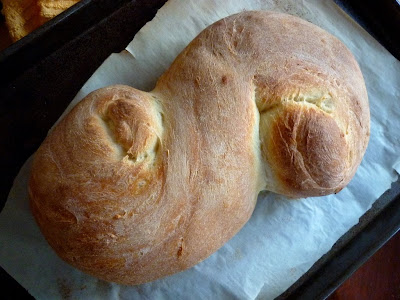I’m sure that if I followed Reinhart’s instructions, step by step, ingredient by ingredient, tedious modification of home baking conditions by tedious modification, I’d get better bread. One of the charms of homemade bread for me, however, is this improvised quality. I don’t want my bread to seem as if it emerged fresh from the hearth of a brick fired oven. So few people bake bread anymore that the simple act of making a loaf at home seems like a monumental accomplishment.
In short: I want to be congratulated for my willingness to bake at home (on occasion). If my bread tasted like it came from a bakery, I’d have to work that much harder for accolades. This bread is really great, but you probably won’t fool anyone into believing it came from the corner Italian bakeshop. And so much the better, I say.
This bread does take two days and involves some advanced planning. If you want to spread it out for three days, you can let the final rise take place overnight in the refrigerator. That’s what the instructions in The Bread Baker's Apprentice
This is a very soft, sweet, tender loaf. The semolina flour gives it a golden color and more rustic texture than a plain white or Italian loaf. I think the honey was a particularly nice complement to the semolina and made this just a touch shy of a sweet bread. Because I like a touch of sweet in my baked goods, I included more of this than the recipe suggested.
I made this to go with soup, and lightly toasted slices of Pane Siciliano with melted cheese were indeed a nice contrast to piping bowls of cauliflower chowder. The bread also maintained its freshness much better than most. I ate it with peanut butter and banana for lunch during my work week, and it still tasted fresh and soft five and six days after baking. Usually, I have to toss out the ends of homemade bread because it either goes stale or moldy before I’ve finished it, but we ate all of this.
Just be forewarned that this recipe really is an approximation. I didn’t measure the honey, for example; I just squirted in about a tablespoon. And my water measurements are quite a bit higher than the original recipe demanded, so you might want to use less than what I specified to begin with and increase as needed should you attempt this in your own kitchen.
The original recipe makes 3 smallish loaves; I halved it and opted for a large one.
Pane Siciliano
Pate Fermente:
1 cup flour (bread flour if you have it; or else use all-purpose and add 1 teaspoon of vital wheat gluten)
¼ teaspoon salt
slightly heaping ¼ teaspoon active dry yeast
½ plus 2 tablespoons water, slightly warm (more if needed)
Pane Siciliano
One Pate Fermente (above)
Scant 1 cup bread flour (or all-purpose with 1-2 teaspoons vital wheat gluten)
Scant 1 cup Semolina flour
½ teaspoon salt
¾ teaspoon active dry yeast
¾ cup water, slightly warm (more if needed)
1 tablespoon honey
1 tablespoon olive oil
Pate Fermente Instructions:
In a medium bowl, mix together flour, salt, and yeast. Add water, stir, and knead for 5-6 minutes. I actually did knead this by hand, as this small amount of dough is too little for a dough hook to really grab onto.
Let rise at room temp for about two hours, or until doubled. Punch down, then cover with plastic wrap and let rise overnight in refrigerator. Can keep for up to 3 days in fridge.
Take the pate fermente out of the refrigerator to take off the chill off about an hour before you want to start the bread. Divide into 3-4 pieces.
In a large bowl of your stand mixer, mix together flours, yeast, and salt. In a measuring cup, mix together the water, oil, and honey. Add to dry ingredients along with pate fermentee. Stir until blended with a spoon, then knead with the dough hook for 5-6 minutes, or until a piece of dough pinched off passes the windowpane test.
Cover with plastic wrap and let rise at room temp for 2 hours or so or until doubled in size. De-gas, trying not to eliminate air bubbles, then shape into a long cylinder about 1 1/4 feet long. Curl the opposite ends to make an “S” shape.
Let rise at room temp until doubled in size, 2 hours, or let rise overnight in the refrigerator.
Preheat oven to 450. Bake for 20-30 minutes on a parchment-paper lined baking sheet, or until golden brown and hollow when thumped. Makes 1 large loaf.
Printable recipe here. I plan to submit this recipe to Yeastspotting.










Looks very delicious!
ReplyDeletePane siciliano is still on my toDo List. As soon as I get some semonlina flour I have to bake it, too.
Thanks! It was really nice ... different, but not crazy different. :)
ReplyDeleteYou rebel you!!
ReplyDeletegorgeous loaf!
I really like your take on bread baking. It should be about improvisation not about following strict rules!
ReplyDeleteThe bread looks like it came out great, tedious modifications or not.
Thanks! It was definitely a fun loaf to play with (and to eat)! :) After my French vacation, I'm reconsidering my antipathy to going to crazy extremes to recreate bakery bread, though!
ReplyDelete